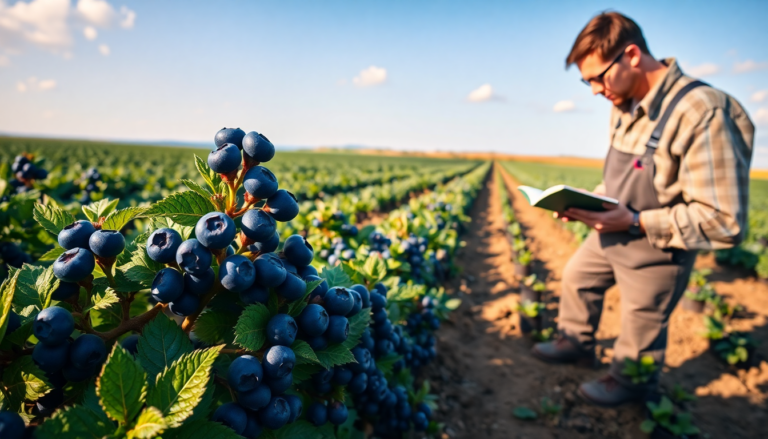Argomenti trattati
Gonzalo Casorzo’s journey from being an agronomy student in Chile to a notable researcher in blueberry genetics at the University of Florida is a fascinating story of passion and adaptability. Originally, he had his sights set on civil engineering, but soon discovered that his true interest lay in agronomy. It was in this field that he found joy in working outdoors and contributing to food production. His various experiences, from internships to advanced studies, have significantly shaped his understanding of genetics and highlighted the importance of collaboration in research.
A Shift from Civil Engineering to Agronomy
Picture this: Gonzalo starts his college journey in civil engineering, thinking that a career with structured office hours sounds appealing. However, after just one semester, he had a revelation. He noticed that agronomists seemed not only happier but also more connected to the tangible results of their work. This realization sparked a desire in him to pursue a career that would allow him to make a lasting impact on food quality and production.
During his undergraduate years, Gonzalo landed an internship with a leading berry company. This opportunity took him deep into the world of blackberry genetics and even led him on a journey to China for blueberry breeding. The hands-on experience was transformative, solidifying his passion for agronomy as he reveled in the challenge of planning and executing breeding programs designed to enhance fruit quality. It was like playing a real-life version of Sim City, where strategic planning translates into successful outcomes.
After earning his bachelor’s degree, Gonzalo transitioned to the blueberry breeding lab at the University of Florida to dive into his master’s program. This shift from student to researcher brought new challenges but also opened the door to working alongside esteemed mentors who shared his enthusiasm for genetic improvement in fruits.
The Power of Collaborative Research
At the University of Florida, Gonzalo has had the privilege of collaborating with exceptional faculty members, including Dr. Patricio Munoz, who has been a crucial mentor. Under his guidance, Gonzalo has navigated the intricate world of managing a breeding program, focusing on research aimed at developing impactful blueberry cultivars. He emphasizes the value of a collaborative lab environment, where ideas can flourish and team members support one another, creating a family-like atmosphere.
One standout experience for Gonzalo was his participation in the Introduction to Quantitative Genetics course. This class sharpened his data analysis skills and real-world application strategies. The hands-on approach to problem-solving equipped him with the tools needed to tackle complex genetic traits. His success in the course led him to become a teaching assistant, further deepening his grasp of the subject matter.
The collaborative spirit in the breeding lab has profoundly influenced Gonzalo’s development as a researcher. The focus on teamwork and knowledge sharing has been vital in navigating the complexities of genetic research, especially as he works on improving the shelf life of blueberries.
Enhancing Blueberry Shelf Life: Research Goals
Gonzalo’s Ph.D. research revolves around understanding the genetics that influence the shelf life of blueberries. Why is this important? Well, shelf life plays a critical role in minimizing food waste and ensuring that consumers have access to high-quality products. By enhancing blueberry shelf life, Gonzalo aims to make a meaningful contribution to the entire supply chain, from producers to consumers.
One significant factor affecting shelf life is fruit softening, which is driven by various biological processes. Gonzalo’s research involves evaluating over 600 blueberry genotypes to pinpoint those that boast superior shelf-life characteristics. By selecting individuals with desirable traits and employing predictive models, he hopes to accelerate the breeding process, potentially cutting down the time needed to develop new cultivars.
The integration of molecular-assisted breeding techniques enables earlier selections in the field, drastically shortening the timeline for cultivar releases. This innovative method not only boosts the efficiency of breeding programs but also aligns with consumer demands for consistently high-quality fresh produce.
Future Aspirations: Bridging Research and Commercialization
As Gonzalo approaches the end of his Ph.D., he envisions a career that bridges the gap between research and commercialization. He aims to leverage his genetic expertise to develop premium fruit products that stand out in the market. He recognizes a significant opportunity in the fruit sector, particularly as consumers increasingly seek quality and are willing to pay a premium for it.
His work on enhancing shelf life is pivotal to this vision, as it raises the perceived quality of blueberries and other fruits. While he remains open to opportunities in both public and private sectors, Gonzalo firmly believes that implementing effective commercialization strategies within public breeding programs can maximize their potential.
In summary, Gonzalo Casorzo’s journey is a powerful illustration of how passion, collaboration, and innovative research can transform the field of agronomy. His dedication to improving fruit genetics and enhancing market quality positions him as a promising figure in the future of agricultural research.

